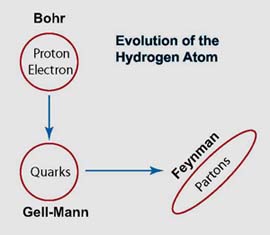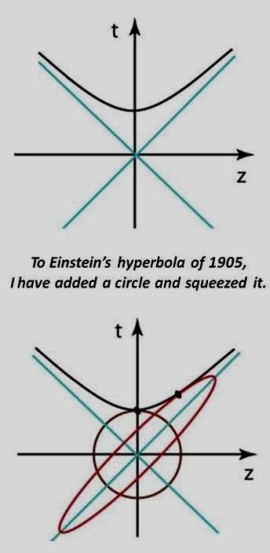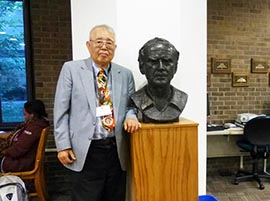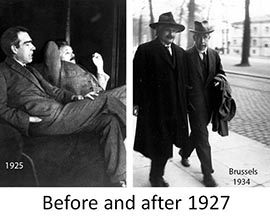Addition to Einstein
Einstein formulated his special relativity in 1905.
One hundred years later, in 2005, he came to me and asked me
what I have done to make him happy. I told him I constructed a
webpage dedicated to him.
- I then asked him what he discussed with Bohr when he met him. Bohr was
interested in the electron orbit of the hydrogen atom. Then I asked him
whether they discussed how the orbit looks to moving observers. He told
me he has no recollection of talking about this problem. At that time,
the moving hydrogen atom (with a relativistic speed) was beyond the scope
of physics. Even these days, it is not possible to accelerate the hydrogen
atom.
- The hydrogen atom played a pivotal role during the transition from
classical mechanics to quantum mechanics where the bound-state orbits are
replaced by standing waves.

- In 1964, Murray Gell-Mann formulated the quark model
where the proton became a quantum bound
state of more fundamental particles called the quarks. Unlike the hydrogen
atom. the proton can be accelerated, and its speed can become as close as
that of light. Then the proton does not appear like a bound state. Indeed,
in 1969, Richard Feynman observed this phenomenon systematically and came up with
his parton picture.
The original hydrogen problem of Bohr and Einstein thus becomes that of whether the parton model is a Lorentz-boosted quark model. Click here for a detailed story.

I learned the mathematics of these figures during my high-school years (1951-54), even though I did not know they have anything to do with Einstein. - Einstein told me the quarks and partons are very strange to him. He asked
to explain in terms of the language he could understand. I then showed this
figure consisting of a hyperbola, circle, and ellipse.
- He was able to recognize the hyperbola shown in the figure.
There is an invariant quantity when we move along this hyperbola.
For example, the particle mass is a Lorentz-invariant quantity.
- I told him I added a circle tangent to the hyperbola.
As the tangential point moves along the hyperbola, the circle
becomes squeezed into an ellipse. The area of the ellipse
remains constant.
As the tangential point moves far away from the center, the ellipse becomes concentrated into the line which makes the 45o angle between the horizontal and vertical axes.
In terms of the language of physics, the circle and the the narrow ellipse correspond to the quark and parton models respectively. Click here for the physics story.
- He was able to recognize the hyperbola shown in the figure.
There is an invariant quantity when we move along this hyperbola.
For example, the particle mass is a Lorentz-invariant quantity.
- Einstein said the mathematics of the circle and ellipse is very easy to
understand, but he asked me whether I did all the physics alone. I said No.
I organized earlier works of Dirac, Wigner, and Feynman. I showed
this table of organization.
- Among those, Paul A. M. Dirac was most inspirational to me. I then told him
this story to Einstein,
and asked him whether he met Dirac. He said Dirac was a young man
from England, and he once met Dirac at
the 1927 Solvay conference.
- It is possible to integrate the works of
Dirac, Wigner, and Feynman to obtain the Bohr-Einstein picture of moving bound
states. Click here for this work as a
an extension of Einstein's E = mc2 .
- I did not have to invent new mathematics. The mathematical framework
was based on what
I learned during my high-school years (1961-54).

I had a photo with Dirac's bust at the Fine Hall Library (for physics and math) of Princeton University (2013). - Among those, Paul A. M. Dirac was most inspirational to me. I then told him
this story to Einstein,
and asked him whether he met Dirac. He said Dirac was a young man
from England, and he once met Dirac at
the 1927 Solvay conference.
- Click here for more about Einstein.

|
This page is maintained by Y. S. Kim.
Photos of Bohr and Einstein are from the AIP E. Segre Visual Archives.